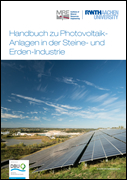PVSEnergie
Practical guidelines for the integration of photovoltaic systems in the German quarrying industry
As part of the energy transition, Germany aims to become climate-neutral by 2045. A key element in achieving this goal is the large-scale expansion of photovoltaic systems. To accelerate the deployment of PV capacity, it is crucial to tap into previously unused land potential to ensure an environmentally and socially sustainable energy transition.
The German quarrying industry comprises around 3,400 companies nationwide, producing approximately 560 million tonnes of primary raw materials each year, including sand, gravel, and crushed natural stone. Many of these operations have unused areas such as quarry floors, slopes, conveyor belts, spoil heaps, and lakes that are suitable for installing ground-mounted, floating, or special photovoltaic systems. Integrating PV can be economically attractive for operators while also contributing to CO₂ reduction, environmental protection, and biodiversity.
So far, however, the vast PV potential of the sector remains underutilised. Significant hurdles at federal, state, and municipal levels in approval procedures complicate the planning and installation of ground-mounted systems on quarrying sites. As a result, uncertainty and hesitation are common among companies, and the expansion has been slow. There is a lack of sector-specific guidance.
Within the PVSEnergie project, we developed a practical handbook. It supports companies in the quarrying industry in the planning, permitting, installation, and operation of photovoltaic systems on their sites. In addition to legal and economic aspects, the handbook also highlights synergies with biodiversity and land reclamation.
Handbook Download
The handbook Photovoltaics in the Quarrying Industry summarises all project results and provides a compact implementation guide. It gives companies a tool to efficiently unlock land for solar power generation and actively advance the decarbonisation of the sector.








